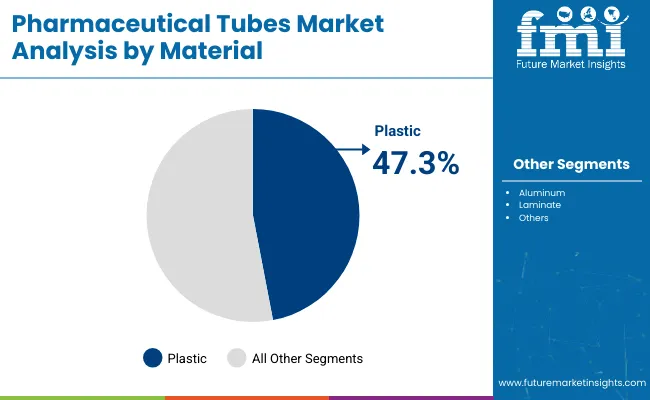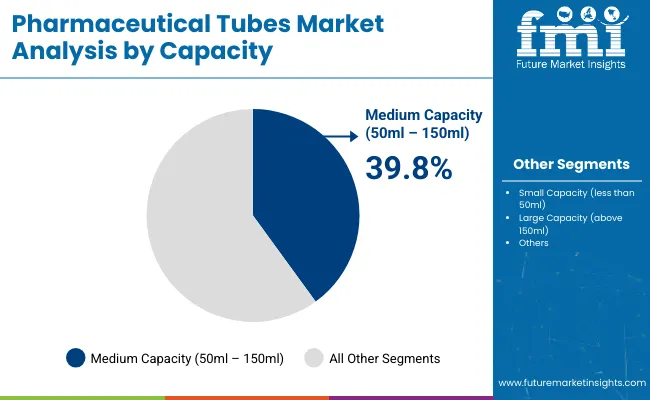The pharmaceutical tubes market is projected to grow from USD 4.9 billion in 2025 to USD 8.3 billion by 2035, at a CAGR of 5.4%. The estimated 2024 sales value stood at USD 4.5 billion. Growth is being propelled by the increasing demand for topical and transdermal drug delivery systems, which favor tubes for their hygiene, portability, and precision. Aluminum, laminate, and plastic tube formats continue to support antibiotic creams, gels, and dermatology applications in both OTC and prescription drugs. Regulatory push for single-use formats post-COVID has further accelerated demand across hospital and clinical supply chains.

| Metric | Value |
|---|---|
| Industry Size (2025E) | USD 4.9 billion |
| Industry Value (2035F) | USD 8.3 billion |
| CAGR (2025 to 2035) | 5.4% |
Recent innovation in pharmaceutical tubes includes multi-layer laminate structures with integrated tamper-evident and child-resistant closures. Barrier enhancements using EVOH, aluminum foils, and UV-cured coatings are extending shelf life for temperature-sensitive drugs. Manufacturers are deploying digital printing and traceability features to meet serialization and anti-counterfeit regulations. New ergonomic dispensing tips and unit-dose tube systems are also improving patient compliance, especially in home care and pediatric markets.
Future market dynamics will be shaped by global pharmacovigilance laws, regional GMP enforcement, and patient safety standards. Companies are expected to prioritize packaging formats that ensure sterility, dosing accuracy, and extended usability. Digital integration with tamper alerts and e-labels is likely to gain ground. As pharmaceutical brands align more with ESG goals, demand for recyclable and bio-based tubes will offer competitive advantages across supply contracts and tender bids.
The market has been segmented based on material type, product type, end-user, application, capacity, and region. Material types including plastic, aluminum, and laminate have been selected to meet regulatory requirements, barrier performance, and sustainability initiatives across dosage forms. Product types such as squeeze tubes, twist tubes, and crimped tubes have been adopted to deliver user convenience, controlled dispensing, and compatibility with various formulations. Applications have been segmented into ointments, creams, and gels, enabling packaging designs to align with viscosity, dosage precision, and patient compliance needs.
Regional segmentation has been carried out across North America, Europe, Asia Pacific, Latin America, and the Middle East & Africa to reflect packaging innovation, pharmaceutical manufacturing presence, and regulatory alignment across developed and emerging markets.

A 47.3% share of the pharmaceutical tubes market in 2025 is expected to be held by plastic due to its lightweight, durable, and chemically resistant nature. Materials such as LDPE, HDPE, and laminated plastic have been commonly adopted for ointments, creams, and gels. These plastics have offered customizable barrier levels for moisture and light-sensitive formulations. Compatibility with high-speed filling equipment has enhanced their industrial value.
Extrusion flexibility has enabled the creation of multi-layer plastic tubes tailored for specific drug packaging needs. Their robustness under various storage temperatures has suited prescription and over-the-counter medications alike. Tamper-evident features and labeling efficiency have improved traceability and patient safety. Plastic has continued to dominate due to cost-efficiency and regulatory compliance benefits.

A 39.8% share of the market in 2025 is projected to be accounted by the medium capacity segment (50ml-150ml), driven by demand for portability and adequate dosing. These formats have been widely used for topical treatments, dermatological products, and oral gels. They have struck a balance between shelf life, patient convenience, and storage efficiency. Manufacturers have preferred these tubes for product line standardization.
Medium-sized pharmaceutical tubes have offered favorable volume-to-surface ratios for product integrity. Drug companies have relied on this size for product trials, physician samples, and direct-to-consumer packs. The segment has also aligned with international labeling requirements and unit-dose packaging strategies. Functional closures and ergonomic design have reinforced usability in hospital and retail environments.
Pharmaceutical Tube is a hollow cylindrical container used as a packaging solution for ointment, creams and many other pharmaceutical products such as dental care toothpaste and skin repair creams. The tubes are having a wide range of pharmaceutical applications, as they offer a cost-effective, safe and tamper-proof packaging solution to pharmaceutical companies.
In recent years many companies have shifted from traditional packaging to tube packaging due to its space-saving design and easy to use features. The overall market for these tubes has witnessed sharp growth in the last decade and is expected to register exponential growth over the forecasted period.
The tubes made up from materials like Aluminum, Plastic and mixed laminates of Plastic and Aluminum are durable and the availability of tubes in all sizes makes it a primary choice for small as well as giant market players of the pharmaceutical industry.
Rising awareness about the skin and oral diseases among the increasingly educated consumer bases in all parts of the world, along with additional shelf life offered by these tubes. All these factors are major driving forces of the pharmaceutical tube market in the upcoming decade.
The waste generated by pharmaceutical tubes is not 100% recyclable, further, the chemical coating used on the outer protection of the tube has negative emissions on the environment.
Also, the stringent rules and regulations restricting usage of pollutant materials in the countries like the USA, Germany regarding usage of raw material used for producing the packaging for pharmaceutical products. Above mentioned factors could hamper the expected growth rate of the pharmaceutical tubes market.
The innovation-driven packaging industry has come up with bio-degradable materials as a result of continuous research & development. Recyclability of the same raw materials like Aluminum and Plastics is enhanced by mixing strength and reducing its carbon impact, the pharmaceutical tubes made up of eco-friendly raw materials offer massive opportunities to the manufacturers.
Also, technological advancements in the field of production and logistical chains have enabled top manufacturers to multiply their production capacity and take full advantage of these opportunities by developed as well as untapped markets.
The rapid development of industrial infrastructure in fast-paced economies like India and China, along with the easy availability of raw materials like plastics and Aluminum for the production of pharmaceutical tubes makes them major growth regions.
The entry of global giants in the region along with newer entrants contributes to the overall growth of the global pharmaceutical tubes market.
France having a developed pharmaceutical sector coming up with innovative products and solutions from time to time, makes it a primary consumer of pharmaceutical tubes as a packaging solution. Usage of bio-degradable materials by manufacturers in the country having an environmentally concerned consumer base offers immense growth opportunities for the global pharmaceutical tubes market in the country.
The rising awareness regarding the skin and oral diseases in the country, along with the high demand for easy to use packaging even for the pharmaceutical offerings makes the USA an important market for pharmaceutical tubes. The presence of global manufacturers of pharmaceutical tubes in the country makes the USA a developed market set to grow shortly.






Our Research Products

The "Full Research Suite" delivers actionable market intel, deep dives on markets or technologies, so clients act faster, cut risk, and unlock growth.

The Leaderboard benchmarks and ranks top vendors, classifying them as Established Leaders, Leading Challengers, or Disruptors & Challengers.

Locates where complements amplify value and substitutes erode it, forecasting net impact by horizon

We deliver granular, decision-grade intel: market sizing, 5-year forecasts, pricing, adoption, usage, revenue, and operational KPIs—plus competitor tracking, regulation, and value chains—across 60 countries broadly.

Spot the shifts before they hit your P&L. We track inflection points, adoption curves, pricing moves, and ecosystem plays to show where demand is heading, why it is changing, and what to do next across high-growth markets and disruptive tech

Real-time reads of user behavior. We track shifting priorities, perceptions of today’s and next-gen services, and provider experience, then pace how fast tech moves from trial to adoption, blending buyer, consumer, and channel inputs with social signals (#WhySwitch, #UX).

Partner with our analyst team to build a custom report designed around your business priorities. From analysing market trends to assessing competitors or crafting bespoke datasets, we tailor insights to your needs.
Supplier Intelligence
Discovery & Profiling
Capacity & Footprint
Performance & Risk
Compliance & Governance
Commercial Readiness
Who Supplies Whom
Scorecards & Shortlists
Playbooks & Docs
Category Intelligence
Definition & Scope
Demand & Use Cases
Cost Drivers
Market Structure
Supply Chain Map
Trade & Policy
Operating Norms
Deliverables
Buyer Intelligence
Account Basics
Spend & Scope
Procurement Model
Vendor Requirements
Terms & Policies
Entry Strategy
Pain Points & Triggers
Outputs
Pricing Analysis
Benchmarks
Trends
Should-Cost
Indexation
Landed Cost
Commercial Terms
Deliverables
Brand Analysis
Positioning & Value Prop
Share & Presence
Customer Evidence
Go-to-Market
Digital & Reputation
Compliance & Trust
KPIs & Gaps
Outputs
Full Research Suite comprises of:
Market outlook & trends analysis
Interviews & case studies
Strategic recommendations
Vendor profiles & capabilities analysis
5-year forecasts
8 regions and 60+ country-level data splits
Market segment data splits
12 months of continuous data updates
DELIVERED AS:
PDF EXCEL ONLINE
Pharmaceutical Autoclave Machine Market Size and Share Forecast Outlook 2025 to 2035
Pharmaceutical Excipient SNAC Market Size and Share Forecast Outlook 2025 to 2035
Pharmaceutical Zinc Powder Market Size and Share Forecast Outlook 2025 to 2035
Pharmaceutical Grade Magnesium Sulfate Market Size and Share Forecast Outlook 2025 to 2035
Pharmaceutical Secondary Packaging Market Size and Share Forecast Outlook 2025 to 2035
Pharmaceutical Glass Packaging Market Size and Share Forecast Outlook 2025 to 2035
Pharmaceutical Manufacturing Equipment Market Forecast and Outlook 2025 to 2035
Pharmaceutical Plastic Bottle Market Forecast and Outlook 2025 to 2035
Pharmaceutical Grade Sodium Carbonate Market Forecast and Outlook 2025 to 2035
Pharmaceutical Industry Analysis in Saudi Arabia Forecast and Outlook 2025 to 2035
Pharmaceutical Packaging Market Size and Share Forecast Outlook 2025 to 2035
Pharmaceutical Grade Sodium Chloride Market Size and Share Forecast Outlook 2025 to 2035
Pharmaceutical Plastic Packaging Market Size and Share Forecast Outlook 2025 to 2035
Pharmaceutical Plastic Pots Market Size and Share Forecast Outlook 2025 to 2035
Pharmaceuticals Pouch Market Size and Share Forecast Outlook 2025 to 2035
Pharmaceutical Unit Dose Packaging Market Size and Share Forecast Outlook 2025 to 2035
Pharmaceutical Mini Batch Blender Market Size and Share Forecast Outlook 2025 to 2035
Pharmaceutical Continuous Manufacturing Equipment Market Size and Share Forecast Outlook 2025 to 2035
Pharmaceutical Liquid Prefilters Market Size and Share Forecast Outlook 2025 to 2035
Pharmaceutical Grade P-Toluenesulfonic Acid Market Size and Share Forecast Outlook 2025 to 2035

Thank you!
You will receive an email from our Business Development Manager. Please be sure to check your SPAM/JUNK folder too.
Chat With
MaRIA